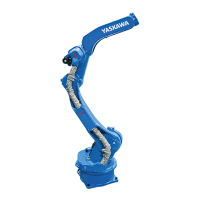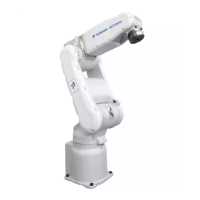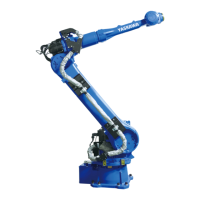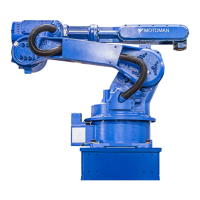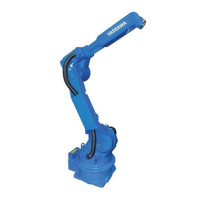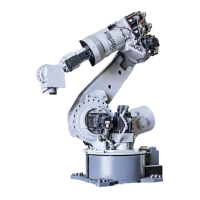6 Operations After Replacing Parts
DX100 6.4 Setting the Second Home Position (Check Point)
6-16
1, Position Check
After the "OUT OF RANGE (ABSO DATA)" alarm occurs, move to the
second home position using the axis keys and perform the position
confirmation. Playback, test runs, and FWD operation will not function
unless "CONFIRM POSITION" is performed.
2, Pulse Difference Check
The pulse number at the second home position is compared with that at
the current position. If the difference is within the allowable range,
playback is enabled. If not, the alarm occurs again.
• The allowable range pulse is the number of pulses per rotation of the
motor (PPR data).
• The initial value of the second home position is the home position
(where all axes are at pulse 0). The second home position can be
changed. For details, refer to chapter 6.4.2 “Procedure for the Sec-
ond Home Position Setting (Check Point)” at page 6-17 .
3, Alarm Occurrence
If the alarm occurs again, there may be an error in the PG system. Check
the system. After adjusting the erroneous axis, calibrate the home position
of the axis, then check the position again.
NOTE
• Home position calibration of all the axes at the same
time enables playback operations without having to
check the position.
• Sometimes in a system with a manipulator that has no
brake, it is possible to enable playback without position
checking after the alarm occurs. However, as a
rule, always perform "CONFIRM POSITION".
Under the above special conditions, the manipulator
moves as follows:
After starting, the manipulator moves at low speed (1/10 of
the maximum speed) to the step indicated by the cursor.
If it is stopped and restarted during this motion, the low
speed setting is retained until the step at cursor is reached.
Regardless of cycle setting, the manipulator stops after the
cursor step is reached.
Starting the manipulator again then moves it at the
programmed speed and cycle of the job.

